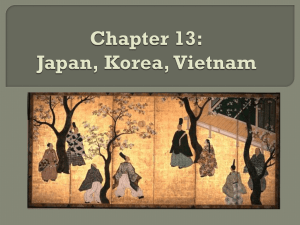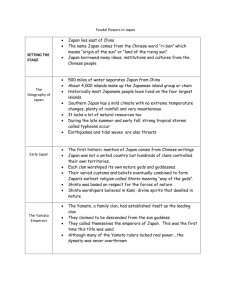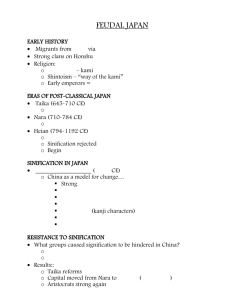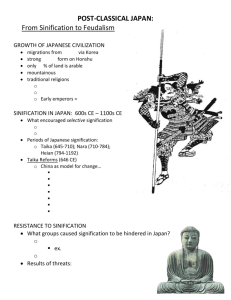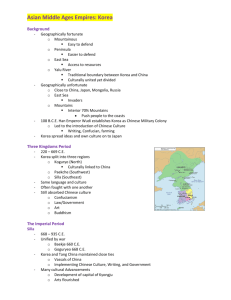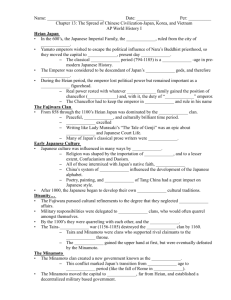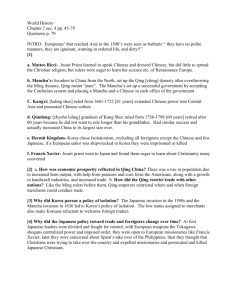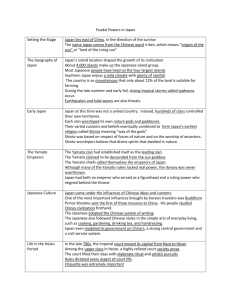Sinification: The Influence of the Middle Kingdom
advertisement
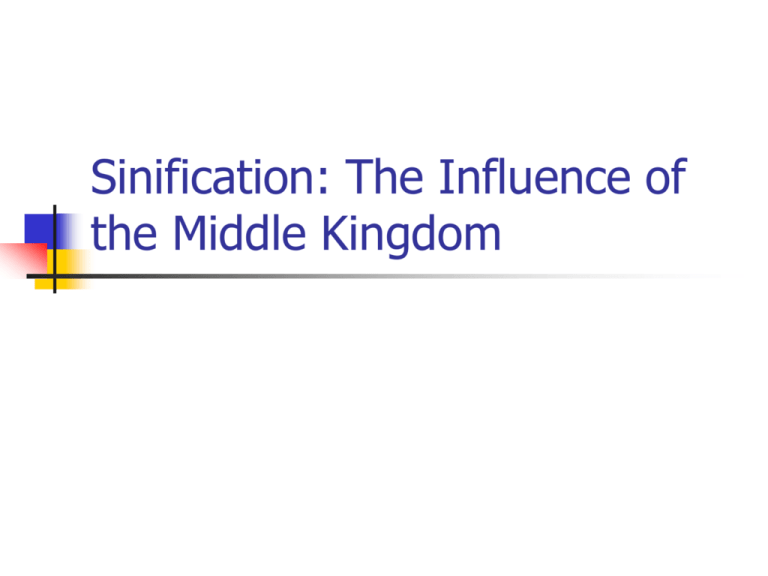
Sinification: The Influence of the Middle Kingdom Writing into the day (possible test question) Compare and contrast the sinification of Asia in the post-classical period with the Helenization of Greek Culture in the Classical Period Reading Quiz 1. 2. 3. 4. 5. 6. 7. 8. 9. 10. These were the attempts to revamp the Japanese political system to more closely resemble the Chinese one. Warrior leaders that administered law were called_______ Mounted troops loyal to their local lords and who lived by a strict code were called __________ Ritual suicide by disembowelment, also known as Hari-Kiri, was called:___________ This type of Buddhism taught that those who lived upright lives on earth might enjoy the bliss of Heaven. These were military warlords that ruled while the emperor was simply a figurehead. The adoption of Chinese culture is referred to as ____________ This earliest Korean Kingdom was conquered by the Han emperor Wudi. These women led uprisings in Vietnam in 39 CE The ________family and the Trinh families were rivals for control of North Vietnam Shinto (Animism) Shinto-"the way of the kami"- is rooted deeply in pre-historic Japanese religious and agricultural practices. The term kami can refer to Japanese mythological deities, but also can mean divinity manifested in natural objects, places, animals, and even human beings. Shinto rituals and celebrations stress harmony between deities, man, and nature -- a key feature of Japanese religious life and art to the present time. Reflecting the understanding that the kami resides in nature, Shinto shrines were traditionally near unusual "concentrations" of nature such as waterfalls, caves, rock formations, mountain tops, or forest glens. Nachi Waterfall, pictured, is an example of a Shino Shrine I. Japan: The Imperial Age Taika reforms were a series of laws attempting to revamp the Japanese Imperial administration along Chinese lines. These took place in the follownig periods: Taika-645-710 Nara 710-784 Heian 794-857 A. Crisis at Nara and the Shift to Heian (Kyoto) The goal of the Taika reforms was to refashion the Japanese monarch into a more absolutist monarch as existed in China (Son of Heaven). The plan was also to create a Chinese style bureaucracy and conscript army, but the aristocrats and Buddhist monastic orders resisted these changes. B. Ultra-civilized: Court Life in the Heian Era Court culture was gracious and well mannered on the surface, but seething with intrigue underneath. The aristocratic classes focused on artistic/aesthetic beauty through art, poetry, and fashion. Codes of behavior-strict rules of etiquette followed in the imperial court. The Poetry of this period focused on beauty and simplicity in nature and often was written by women, who were a strong cultural force in Japan in this period. I. Japan: The Imperial Age (continued) C. The Decline of Imperial Power The Fujiwara family recognized that the Emperor and others in the court were focused on fashion, poetry and art, and there was a lack of real leadership in Japan. Therefore, they, through a series of political marriages, ran the country by proxy, building the infrastructure and strengthening the power of Buddhist monasteries. They ignored, however, the growing power of regional warlords, who led to the Japanese Feudal Period D. The Rise of the Provincial Warrior Elite bushi –warrior leaders from the mini-sates/provinces. They administered the law, Samurai- Mounted troops that were loyal to local lords. The warrior class developed out of these Bushi and samurai, and these samurai were What was the samurai code? Identify Seppuku Describe Salvationist Buddhism II. The Era of Warrior Dominance A. The Declining Influence of China In 838 the Japanese began its discontinuation of emissaries to Chinese courts. The Japanese emperors stopped seeing ht importance of bowing before the Chinese “son of Heaven.” The Gempei wars raged at this time, culminating in Bakufu government (military dictatorship) lead by the Minamoto. B. The Breakdown of Bakufu Dominance Yoritomo-the leader of the minamoto that established an early shogunate. Minamoto -a powerful Japanese family that formally ruled Japan on behalf of the emperor, though it was the Hojo family that had real military power. The role of the Emporer during the Feudal period was mostly as a figurehead. -Ashikaga Takuaji was a minamoto warlord who established a powerful shogunate that lasted from 1336-1573, called the Ashikaga Shogunate? -From 1467-1477, a massive civil war erupted between rival factions, fracturing the country. The Emperors at this point had lost all power, and the Daimyo had control, ruling over nearly 300 tiny kingdoms. II. The Era of Warrior Dominance (continued) C. Toward Barbarism? Military Division cause Social Change in that, while the society was set up for the warrior class to fight and operate under Bushido, or the Samurai Code, the peasantry were starving and the infrastructure weak, Daimyos recognized this and began to stabalize their territories by creating incentives to farm as well as irrigation sytems to aid in the productivity of their region. Warfare changes as armies become larger. Less emphasis is placed on the individual battles of famous samurai, and more importance was placeed on large armies, often made up of peasants and Ronin. II. The Era of Warrior Dominance (continued) D. Artistic Solace for a Troubled Age Zen Buddhism is important in securing a place for the arts during a period of war and strife. Zen monasteries also provided diplomatic and trade contacts with China. Zen ideology also influenced the architecture of the Period. III. Korea: Between China and Japan Korea was influenced by China and Japan, but despite being considered simply a northern Appendage of China, Korea developed its own unique dress, cusine, and social class system quite independent of China and Japan. Unlike China, the ancestors of Korea came from eastern Siberia and Manchuria. A. Tang Alliances and the Conquest of Korea The Choson kingdom in 109 BCE was conquered by the Han emperor Wudi. This led to the channeling of Chinese culture into Korea. The Koguryo people in the North of Korea resited Chinese rule and began civil war, leading to a fractured society This splintering of Korean power allowed Chinese culture to seep into Korea, leading to a mass adoption of Chinese ideas, referred to as Sinification? III. Korea: Between China and Japan (continued) B. Sinification: The Tributary Link The Silla and Koryo dynasties (668-1392) saw the greatest influence of Chinese culture, with sinified versions of Buddhism entering as well as an adoption of Chinese writing and bureaucracy. C. The Sinification of Korean Elite Culture The Silla capital, Kumsong mirrored the Chinese capital during the tang empire. III. Korea: Between China and Japan (continued) D. Civilization for the Few the Aristocracy was highly influenced by China and were very civilized, bu thtis was a tiny segment of the population. E. Koryo Collapse and the founding of the Yi dynasty The Yi dynasty was formed in 1392, and lasted mostly uninterrupted until 1910. Writing into the day (possible test question) Compare and contrast the sinification of Asia in the post-classical period with the Helenization of Greek Culture in the Classical Period IV. Between China and Southeast Asia: The Making of Vietnam A. Conquest and Sinification Describe the Han expansion into Vietnam B. Roots of Resistance Describe the 39 C.E., Revolt of Trung sisters In what way was this unique? IV. Between China and Southeast Asia: The Making of Vietnam (continued) D. Describe the Vietnamese Drive to the South E. Expansion and Division Identify Hanoi Describe the Nguyen dynasty
